The Top 15 Historical Sites in Spain that You Need to See

Spain is without a doubt one of the most fascinating countries to visit not only in the Iberian Peninsula (which consists of Spain, Portugal, Gibraltar, and parts of France), but the whole of Europe too.
It is a country that is rich in history and has many amazingly impressive historical landmarks worth visiting, from the regal splendor of the Alhambra Palace in Granada to the awe-inspiring magnificence of La Sagrada Familia in Barcelona.
Indeed, knowing which place to visit in Spain is a tough choice, as there are beautiful cities and architecture all throughout the country, from the north to the south.
In this blog post we’ll examine the 15 top historical places in Spain in detail. I have both lived in Spain and visited this wonderful country, and will share some insights that will help you as you plan your trip.
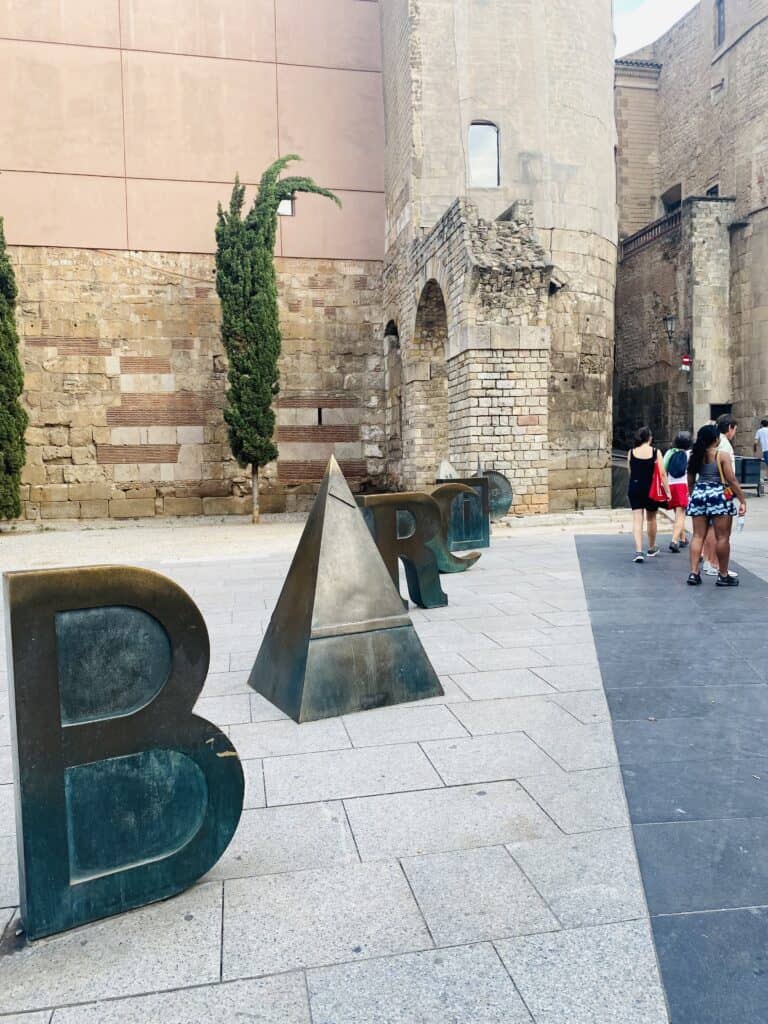
Brief History of Spain
Spain has a complex and rich history, so for the sake of convenience we’ll break it down into 5 periods:
The Palaeolithic Era
Human habitation in what is today known as Spain dates all the way back to the Palaeolithic Era. During this period, the area was home to various indigenous tribes such as the Iberians, Celtiberians, and Tartessians. These cultures flourished for centuries and laid the foundation for Spain’s diverse cultural heritage.
Roman Conquest
During Roman times, 218 BC to be exact, Spain fell under control of the Roman Empire, and this lasted until the 5th century AD. Roman Hispania as it was known back then, established cities, roads, and aqueducts, leaving a lasting impact on Spain’s culture and infrastructure.
The Moors and Islamic Spain
One of the most transformative periods in Spain’s history was the Moorish conquest in 711 AD. The Moors, mostly North African Muslims, established a multicultural society that lasted until 1492. This period left a profound influence on the culture, architecture, and language of the region.
Colonial Spain
Also in 1492, Christopher Columbus set sail on his historic voyage to Latin America, opening up a new era of exploration and colonization. Unfortunately, this was a period of near apocalyptic level devastation to the Americas, but quite lucrative to Spain. The country soon became a major global power, amassing vast wealth from its American colonies.
Modern Era
By the 19th century, Spain experienced social and political upheaval, including events such as the Peninsular War. It is during this period the Spain lost many of its colonies, such as Cuba, Puerto Rico, the Philippines, and Guam during the Spanish-American War in 1898. These losses marked the end of the Spanish Empire.
After the turn of the century, the Nationalists, a fascists rebel group led by General Francisco Franco rose to power, following the Spanish Civil War in the 1930’s. Franco ruled as a fascist dictator until 1975, which ended a period of political repression in the country.
Spain moved to become a democracy after his death, establishing a constitution that allowed for autonomy of the various regions in the country. Spain’s economy rapidly modernized after this, and the country joined the European Union in 1986.
Today, Spain is known as a vibrant, culturally rich country with a robust and diverse industry. It has a thriving tourism sector, fueled by its historical heritage, gastronomy, and picturesque landscapes.
The Top Historical Sites in Spain
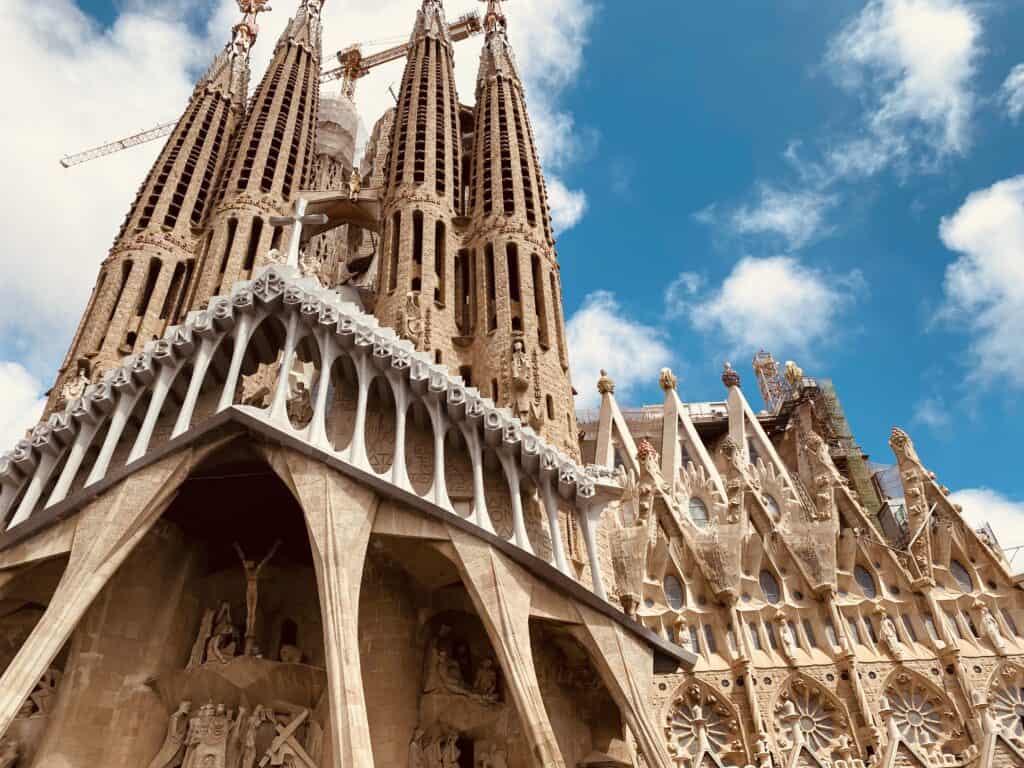
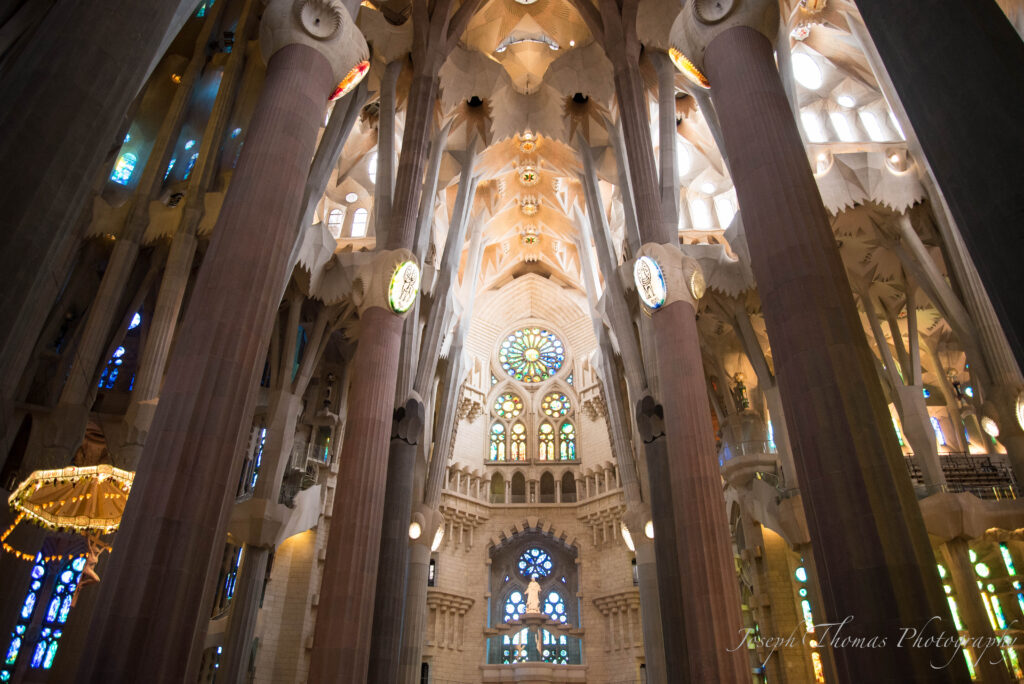
1 | La Sagrada Familia
Location 📍 | Barcelona, Spain | C/de Mallorca, 401, 08013
One of the most iconic historical places in all of Spain is La Sagrada Familia, which is the number one tourist attraction in the whole country.
This UNESCO World Heritage site has been under construction for 140 years and is expected to be finally finished in the next ten years or so. It has a totally unique Spanish Gothic style and was created by the famous Spanish architect Antoni Gaudi.
There is simply no other Catholic Church or other religious temple that is similar to this building and it features 18 towering pillars and multiple sculptures of biblical figures. I have visited this site a few times, and what has really captivated me is the beautiful colors that you find inside the cathedral ceilings and walls.

Pro Tip: With this being such a popular tourist site, it is worth buying your tickets in advance online rather than turning up in hope on the day. Expect to spend a good couple of hours at least when visiting this amazing architectural feat. Click here to purchase you skip-the-line tickets now!
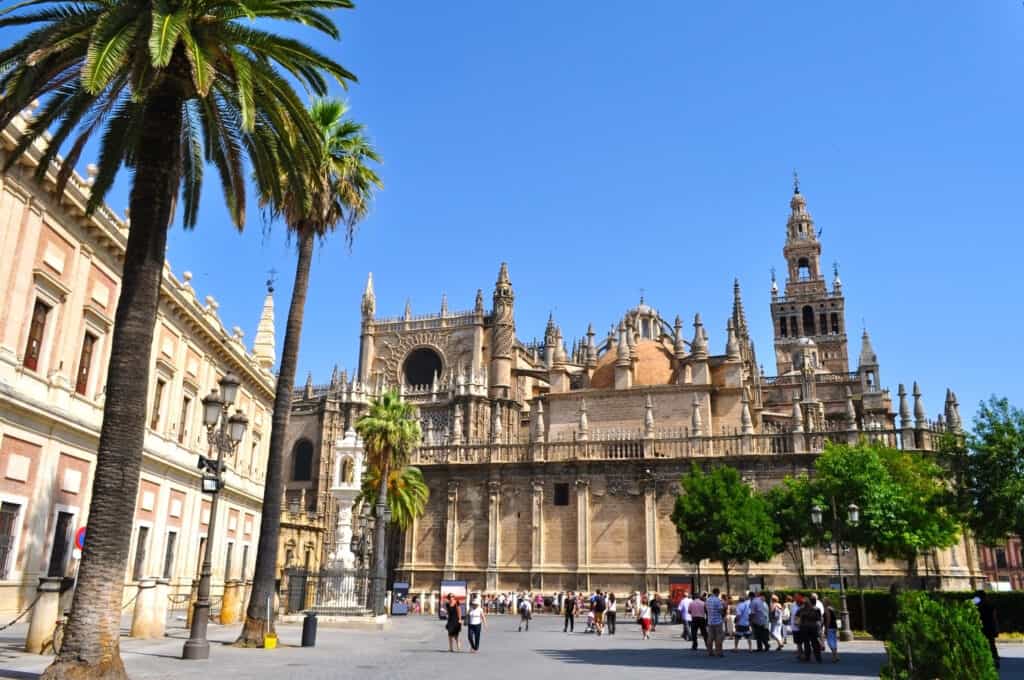
2 | Seville Cathedral
Location 📍 | Sevilla, Spain | Av. de la Constitución, s/n, 41004
Southern Spain, otherwise known as Andalucía, features one of the country’s best historical sites in the region’s capital city; the Seville Cathedral. Situated in the city centre, it sevwas completed in the early 16th century and is known as the largest Gothic church in the world, and is unmissable when in Seville.
The interior of this Roman Catholic Cathedral is breathtaking and features beautiful artwork, countless chapels, sculptures and religious artifacts.

Pro Tip: As it is one of the Sevilla’s most popular tourist attractions, it’s best to book your tickets online in advance to avoid the long queues.
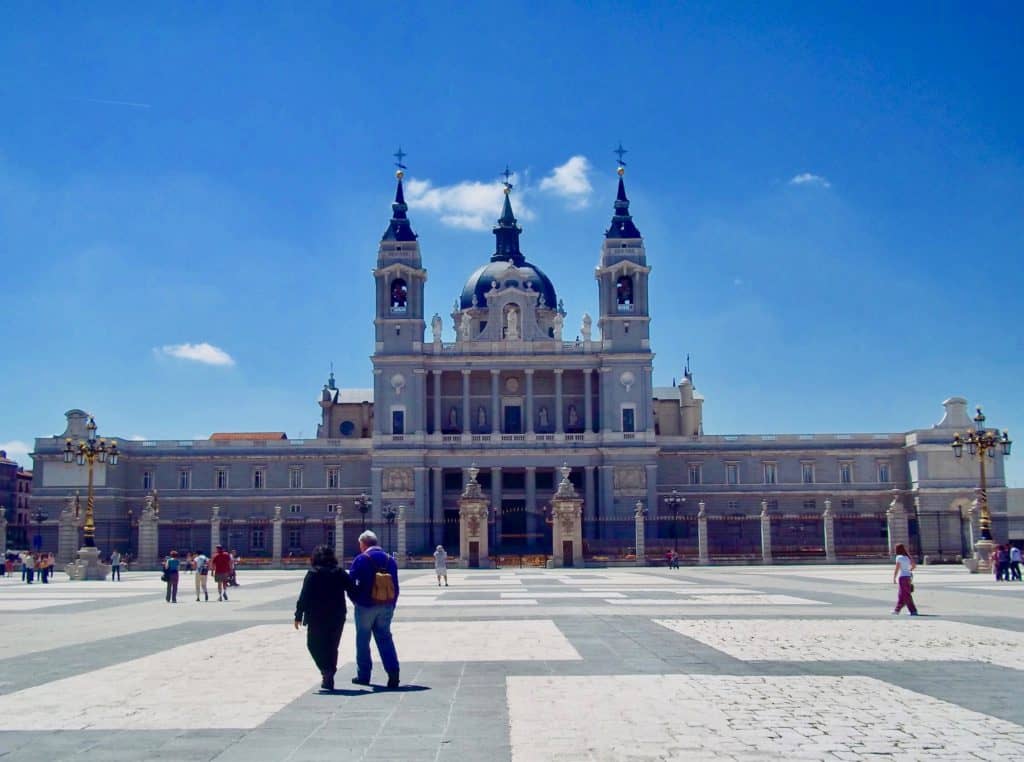
3 | Royal Palace of Madrid
Location 📍 | Madrid, Spain | C. de Bailén, s/n, 28071
Of course, one of the best cities to visit in Spain is its capital in the centre of the country; Madrid. This is a lively, beautiful, energetic city which is full of fascinating historical landmarks.
The number one historical landmark in the Spanish capital is the Royal Palace, which was built in the 18th century to replace a former Moorish Castle. It was home for the Spanish royal family but today it is only used for state ceremonies.
This is the largest royal palace in all of Europe and has over 3,000 rooms worth exploring. You can expect to spend several few hours here when visiting – I certainly did! It’s a magnificent structure, full of impressive rooms such as the Throne Room and Royal Armory. The palace reminded me a lot of Versailles, namely due to the the style of the rooms and furniture found inside.
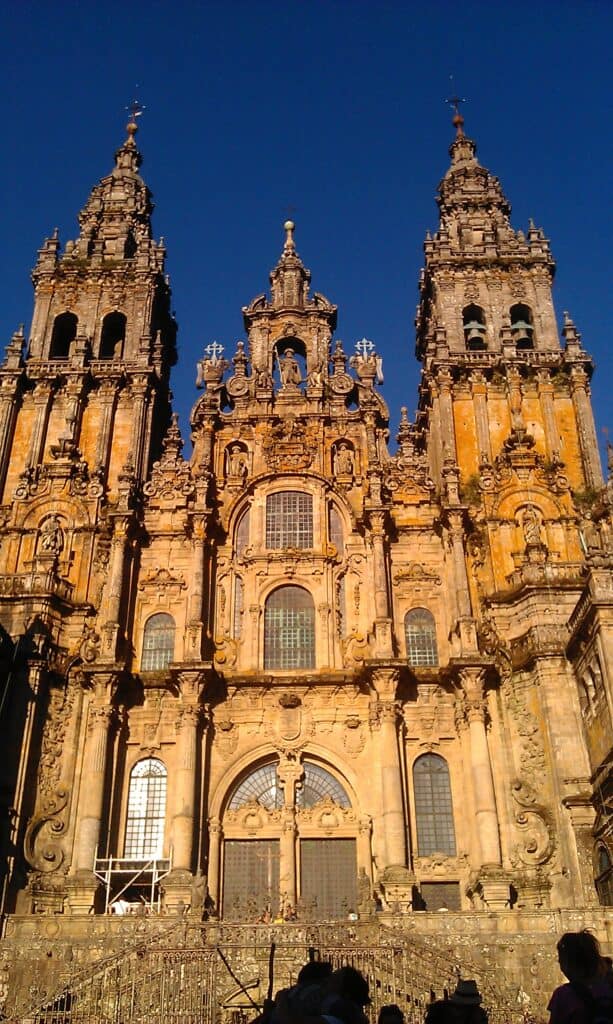
4 | Santiago de Compostela Cathedral
Location 📍 | Santiago de Compostela | Praza do Obradoiro, s/n, 15704
The north of Spain is a full of historical cities, no more so than the Galician capital in the north west; Santiago de Compostela. This is one of the most gorgeous, historical cities in the whole country and is dominated by its towering cathedral. It features Baroque styled architecture and its construction began back in 1075.
The cathedral is significant as it marks the end point for people who participate on the Camino de Compostela, which is a series of ancient pilgrim paths across Spain and Europe that all lead to this building.
It’s said that the building is the burial site of St. James, one of Christ’s apostles and therefore attracts many visitors from all around the world each year. You can enter the cathedral for free and mass takes place four times each day and is attended by many tourists.
There is the traditional swinging of incense that takes place during each mass, which is known as the: ‘Botafumeiro’. This takes up to eight men to begin each swing, sending the incense holder swinging up to 20 feet high inside the Cathedral, which is quite a dramatic sight to see.
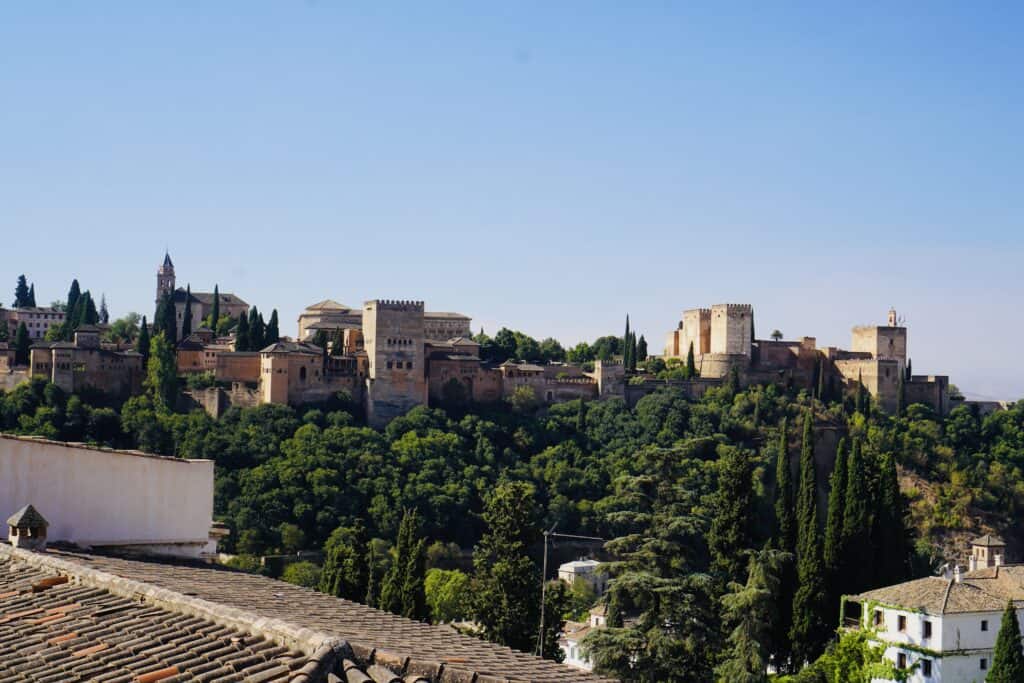


5 | La Alhambra
Location 📍 | Granada, Spain | C. Real de la Alhambra, s/n, 18009
La Alhambra, or the Alhambra Palace, is the most best preserved example of Moorish and Islamic architecture in the whole world, making it a must see when in Spain. The palace is located in Granada, a beautiful city in the south of Spain, surrounded by the Sierra Nevada Mountains. La Alhambra was originally a fortress and later became a royal residence and court during the 13th century.
The whole complex takes around 3 to 5 hours to visit as it is full of aesthetically pleasing architecture that has to be seen to be believed. One of the best buildings to see in the whole complex is the Comares Palace, which was the official residence of the King; Sultan Yusuf I.
On the east site of the complex are the stunningly lush Generalife gardens and is not to be missed as well. This was the former summer palace for the Nasrid rulers of Granada, and contains some of the oldest Moorish gardens in the world.

Pro Tip: La Alhambra is an extremely popular historical landmark and if you don’t book tickets in advance, you may actually not be able to visit the whole site. (This happened to me my second time there). Book your tickets at least several days in advance to avoid missing out! Click here to book your tickets now.
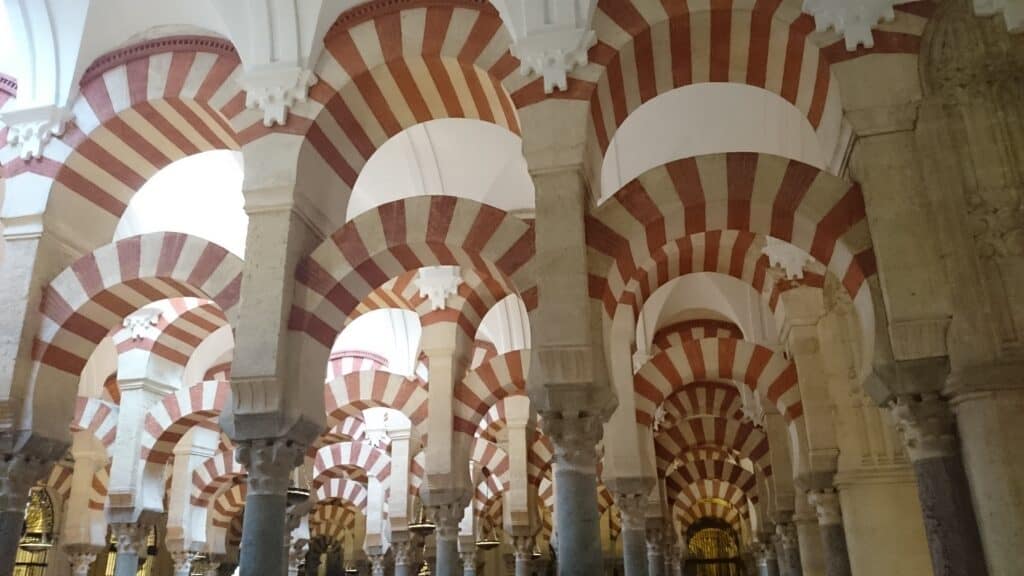
6 | Great Mosque of Córdoba
Location 📍 | Córdoba, Spain | C. Cardena Herrero, 1, 14003
Located just a two hour drive north west from Granada is Cordoba, which is another city in Spain full of historical significance. Cordoba was an important Roman city and before that a major Islamic centre.
The Great Mosque is the main attraction of the historic center of Cordoba, and is one of the greatest examples of Islamic architecture in the world. The building was constructed back in 784 AD as a small Visigothic church. However, the site was divided into Muslim and Christian worship areas after the Islamic conquest of Spain in the 8th century. Later, it was fully converted into a mosque and underwent extensions under the Umayyad Caliphate, making it one of the largest mosques in the world at that time.
The Mosque’s most stunning feature is the expansive prayer hall, noted for its red and white horseshoe arches that create a striking visual effect. The mihrab, a niche indicating the direction of Mecca, is adorned with Byzantine mosaics, showcasing the artistic grandeur of the Caliphate period. In the 13th century, following the Reconquista, the Mosque was converted into a Roman Catholic Cathedral, the Cathedral of Our Lady of the Assumption.

Pro Tip: The best time to visit the mosque is early morning or after 4PM. Note, you will avoid the crowds in the early morning, but note, if you are interested in a guided tour, you cannot do it until later in the day.
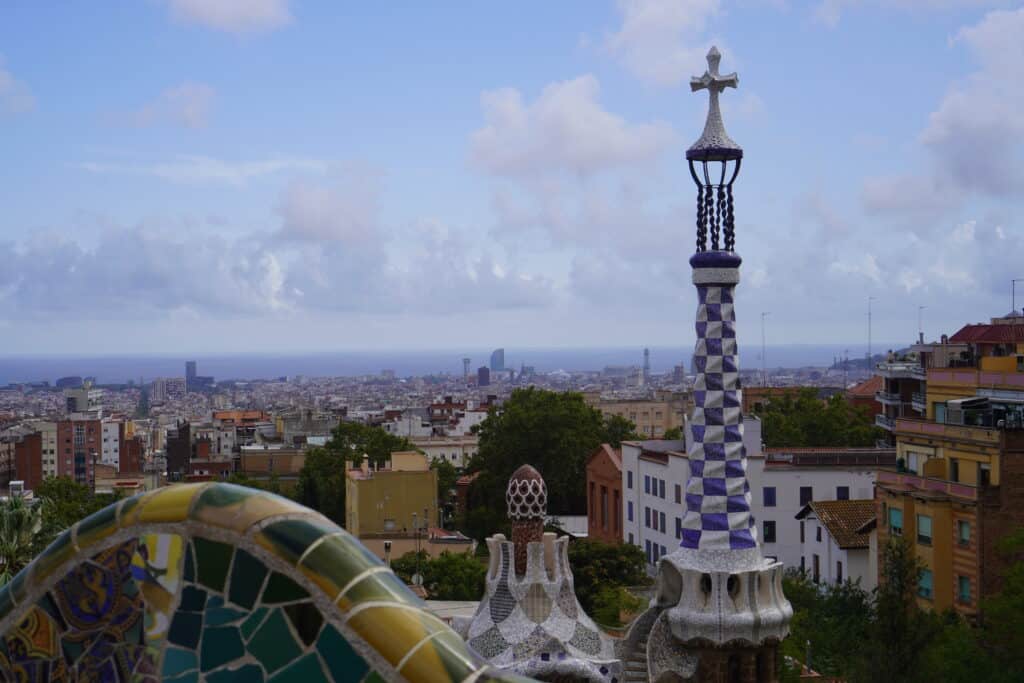
7 | Park Güell
Location 📍 | Barcelona, Spain | 08024
Based on Carmel Hill by the mountain range of Collserola in Barcelona is Park Güell. This place is a huge garden area full of beautiful architecture designed once again by Spanish architect Antoni Gaudi.
The park opened in 1926 by entrepreneur Count Eusebi Güell, who was inspired by English city gardens of the time. It is full of unique artistic features that Gaudi is famed for and it’s quite a magical place to stroll around for a couple of hours.
I make a point to visit this park every time I visit Barcelona. In addition to being a beautiful green space, it also offers fantastic views of the city below too.

Pro Tip: Park Güell is always busy, especially during weekends. The best time to visit is early mornings during the week. The park is open from 9.30 until 7.30pm and it’s open every day of the year.
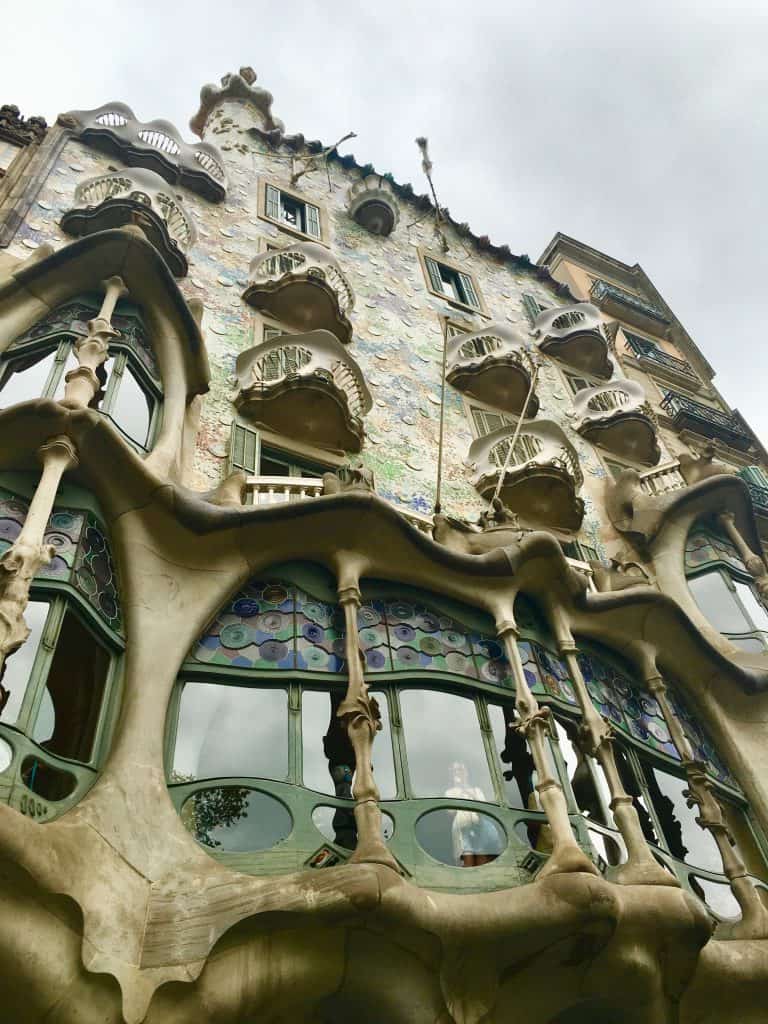
8 | Casa Batlló
Location 📍 | Barcelona, Spain | Pg. de Gràcia, 43, 08007
Casa Batlló is another unique historical landmark in the city of Barcelona created by, you guessed it; Antoni Gaudi! This building is considered by many as his masterpiece and is one of the most beautiful examples of modernism in the world.
It attracts a million visitors each year and has been refurbished several times since Gaudi redesigned it from its previous form in 1904. It’s open every day of the year and it is possible to have an audio guide when visiting the building, which helps explain the history of the building.
If you visit Barcelona in the summer, you can get to experience their “Magic Nights” where they have a series of rooftop concerts. I did this the last time I was in Barcelona and loved it.
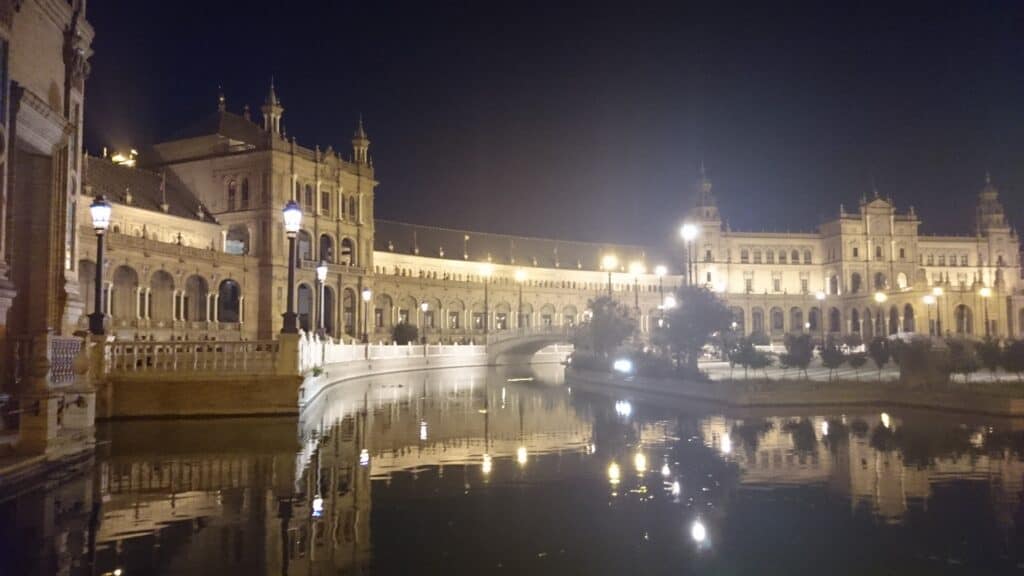
9 | Plaza de España
Location 📍 | Sevilla, Spain
Plaza de España in Sevilla is a beautifully charming place to visit in the capital of Andalucía, and a nice oasis away from the crowds of the city.
It was built for the 1929 Ibero-American Exposition and is shaped in a semi-circle. You can access some of its buildings by crossing four separate bridges over its moat and it is possible to hire a row boat for a ride on its lake if you’re in a romantic mood.
There are many tiled alcoves around the plaza which features artwork of each different region of Spain. The centrepiece of the plaza is the Vicente Traver fountain.
Visiting the plaza is completely free, though it is best to avoid visiting during the afternoons, especially during the summer months when Seville experiences extremely high temperatures. Alternatively, an early morning visit is a good idea, or at night time when the plaza lights up, making it even more magical.
10 | Alcazar of Toledo
Location 📍 | Toledo, Spain
Toldeo is a beautiful UNESCO heritage city based around 45 minutes outside of Madrid. It’s famous for it’s’ sword making and has many historical landmarks, the most famous being the Alcazar of Toledo.
This quadrangle building sits on top of the city’s highest point and dates back to the 3rd century Roman era of the country. Back then it was used as a palace until it was turned into a fortress in the 10th century.
Today it is used as the city’s army museum and has a huge collection of historical military items on display. It’s open from 10am until 5pm throughout the year and you can expect to spend 1 to 3 hours here when visiting.
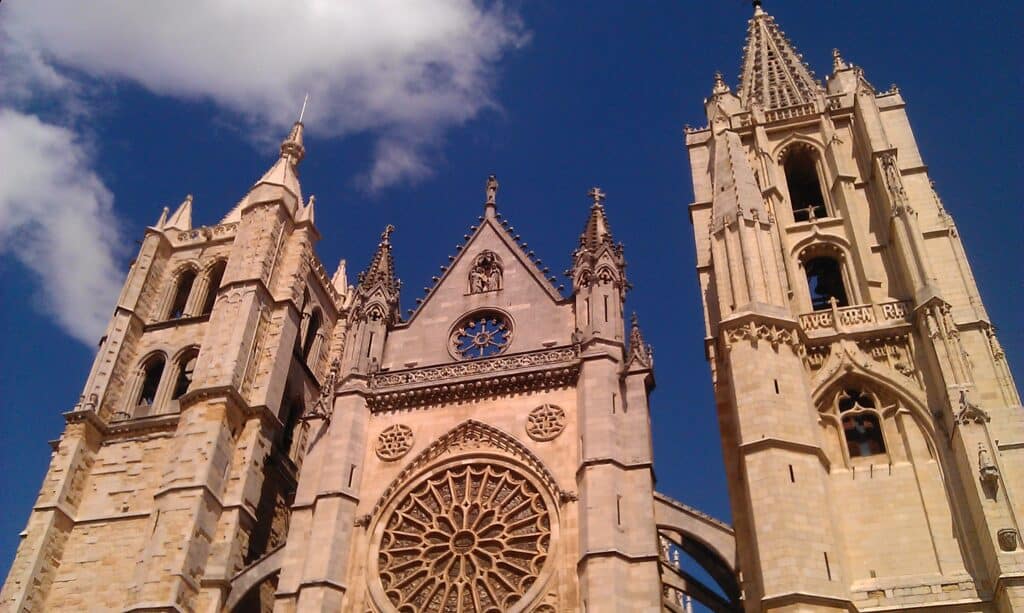
11 | Burgos Cathedral
Location 📍 | Burgos, Spain | Pl. Sta. María, s/n, 09003
Another fascinating city in the north of Spain is Burgos, which is full of fascinating medieval architecture. Burgos is situated along the French route of the Camino de Santiago, and is the provincial capital of Spain’s autonomous community of Castile and Leon.
This medieval city is full of Cathedrals and churches which have remained intact over the years and remain in great condition. The most impressive building is the Burgos Cathedral, which is based in its’ historical centre and is indeed the centrepiece of the city.
The Catholic cathedral is famed for its’ gothic style and it took a few hundred years to be fully constructed, from 1221 to 1567. It’s open most days throughout the year and is relatively cheap. Its interior is full of amazing artwork, tombs and beautiful stained glass windows.
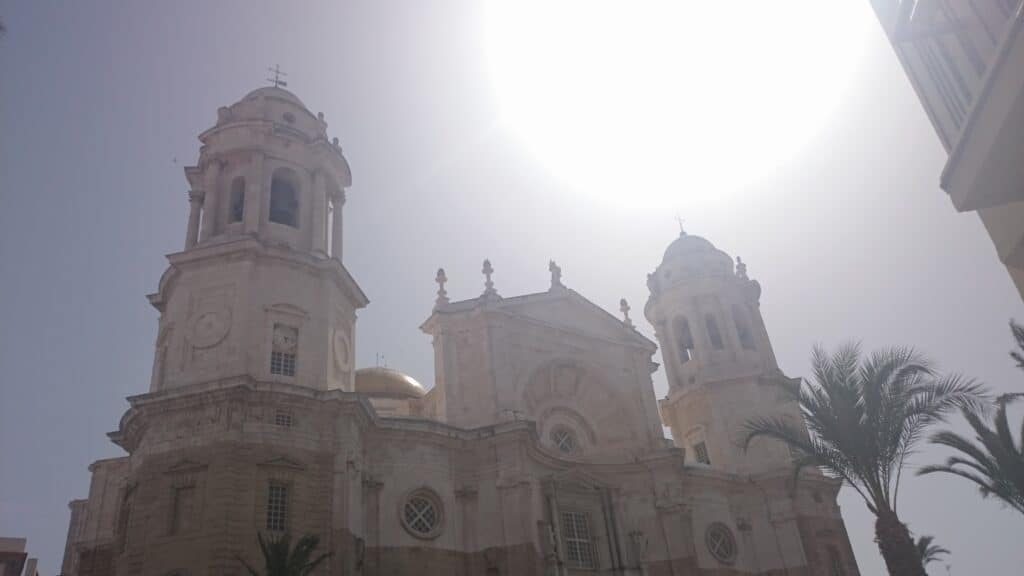
12 | Cadiz Cathedral
Location 📍 | Cadiz, Spain | Pl. Catedral, s/n 11005
Cadiz is a delightful ancient port city in the southwest of Andalucía and is definitely worth visiting if you’re in the area. The city’s most iconic building is its’ Roman Catholic Cathedral, located in the central square.
It’s an impressive sight made in the Baroque style and is actually quite modern compared to most of the other historical landmarks in this post, having been built from 1722 to 1838.
It’s cheap to enter and inside you can see the tomb of Manuel de Falla, the most distinguished Spanish composer of the 20th century. It features a tower which offers panoramic views of Cadiz’ coastline and the Mediterranean sea.
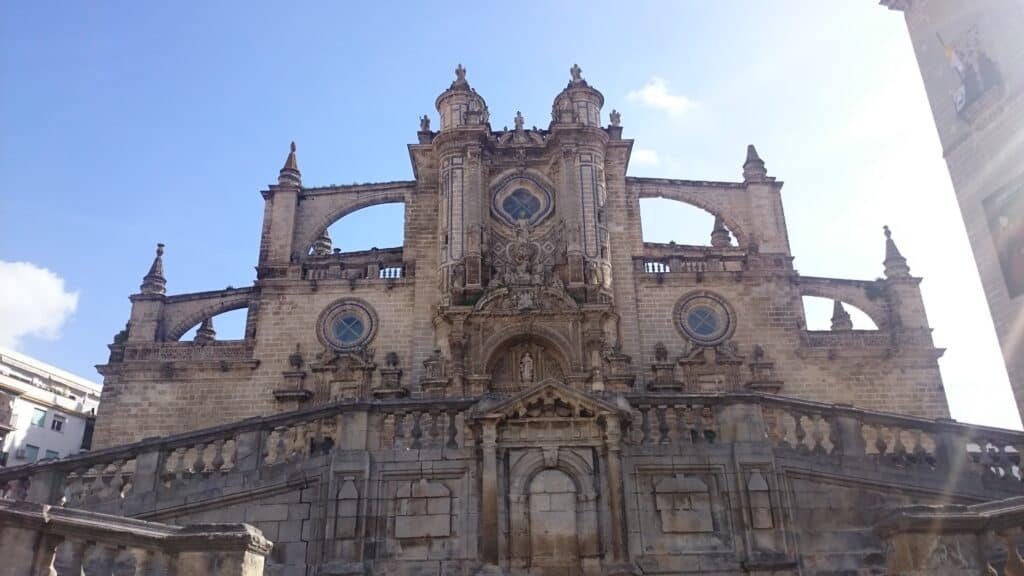
13 | Jerez Cathedral
Location 📍 | Jerez de la Frontera, Spain | Pl. Encarnación, s/n, 11403
Not too far away from Cadiz is another ancient city; Jerez de la Frontera. This charming place is famed for its’ sherry bodegas, flamenco dancing, horse riding and of course, historical landmarks.
The most impressive historical building in Jerez is its’ Cathedral, which is the seat of Roman Catholic Diocese of Asidonia-Jerez. The architecture of the Cathedral consists of Baroque, Gothic and Neoclassical styles and is quite an imposing sight worth seeing.
14 | Tower of Hercules
Location 📍 | La Coruna, Spain | Av. Navarra, s/n 15002
La Coruna is a beautiful port city in Galicia in the very northwest of Spain, surrounded by beaches and a busy port. La Coruna’s main attraction is its Tower of Hercules, which is the oldest lighthouse in the world and dates back to the Roman era in the 1st century.
It’s located just over two kilometres from the city centre, and it is possible to climb to the very top, where there are stunning panoramic views of northern Spain’s coastline and the Atlantic ocean.
The surrounding area of the tower is an amazing place too. There is a statue of Breogán, a Celtic King, and also nearby is the Menhires Pola Paz. These are monuments consisting of ten upright granite sculptures in a circle. They are quite reminiscent of Stonehenge in the UK, albeit on a smaller scale.
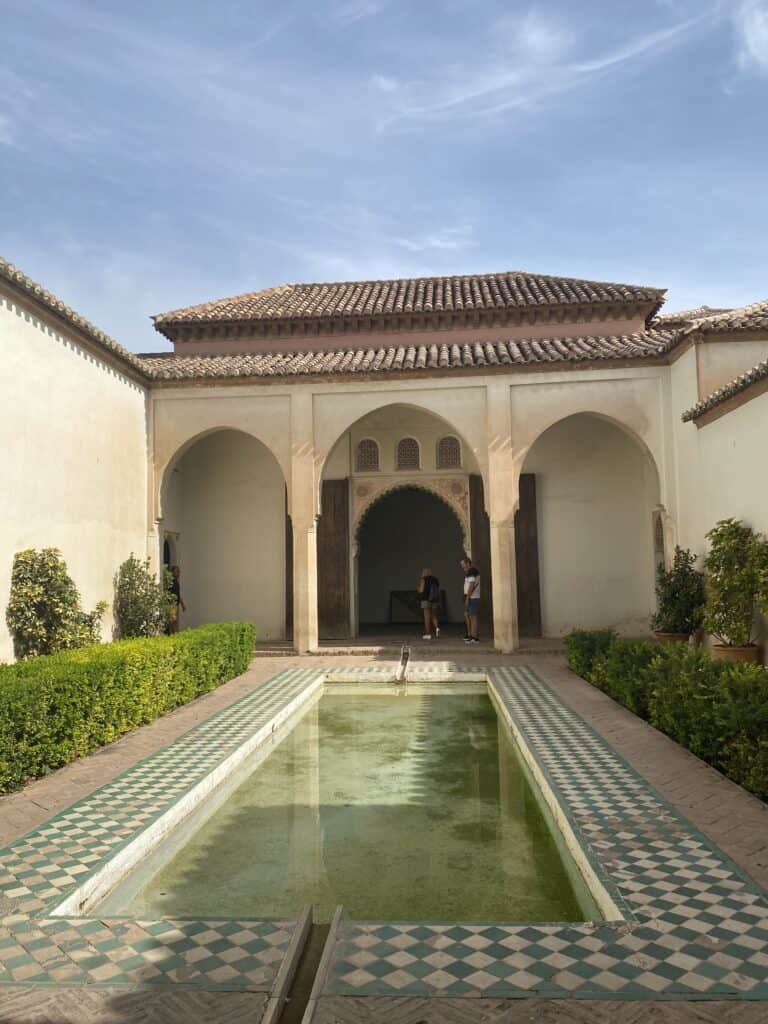
15 | Alcazaba
Location 📍 | Malaga, Spain | C / Alcazabilla, 2, 29012
The Alcazaba of Malaga, nestled on the foothills of Mount Gibralfaro, is a palatial fortress that reflects the splendor of Moorish rule in Andalusia. Constructed in the 11th century under the reign of the Hammudid dynasty, it served as a stronghold for Arab monarchs, showcasing the architectural prowess of the era. The fortress, featuring a double-walled defense system and numerous towers, is an exquisite blend of Roman masonry techniques and Islamic artistic sensibilities.
Today, the Alcazaba remains as one of the most visited tourist destinations in Malaga. It opens its doors to the public every day, inviting history enthusiasts and architecture lovers to delve into an immersive journey into Spain’s Islamic past.
The fortress also offers a magnificent view of the city and the Mediterranean Sea from its walls, a sight that no visitor should miss.
Audio guides are available in multiple languages, providing invaluable insights into the history and architecture of the fortress.

Pro Tip: The best time to visit the Alcazaba is early morning or evening as it is quite a climb to reach the top. Expect to walk for about 20 minutes or so uphill.
FAQs | Historical Sites in Spain
La Sagrada Familia in Barcelona is easily the most visited historical site in Spain, with an estimated 5 million tourists visiting the site each year. An estimated 20 million visit the surrounding area as well.
The oldest town in Spain is considered to be Cadiz. Located in the region of Andalusia, Cadiz was established by the Phoenicians around 1100 BC. Its rich history, spanning over 3,000 years, imparts an unparalleled charm to the city, making it a fascinating destination for history enthusiasts.
Mérida, a city located north of Seville and close to the Portugal border, features the most Roman ruins in the whole of Spain. This includes an impressive amphitheatre, bridges, aqueducts and more.

In Summary | The Top Historical Landmarks in Spain
That concludes this post on the top historical landmarks in Spain. There are so many fascinating historical cities all throughout the country, which explains why it has been such a popular tourist destination for so long.
There are several top destinations worth visiting as well, from the popular Barcelona with many a Gaudi masterpiece, to the regal buildings of Madrid and the stunningly beautiful Islamic architecture found in Andalucía.
If you’re a fan of history or just appreciate beautiful architecture, then Spain must be at the top of your list to visit. It’s a beautiful country full of outstanding history, art and culture. If you are heading to Spain for the first time soon, click here to learn what cities you should visit first!
More Spain Travel Guides:
- 4 Days in Barcelona
- 2 Days in Sagunto
- 2 Days in Granada
- 1 Day in Malaga
- Barcelona to Andorra
- Spanish for Travel
- The Best Places to Visit in Spain
Don’t forget to pin this for later!


